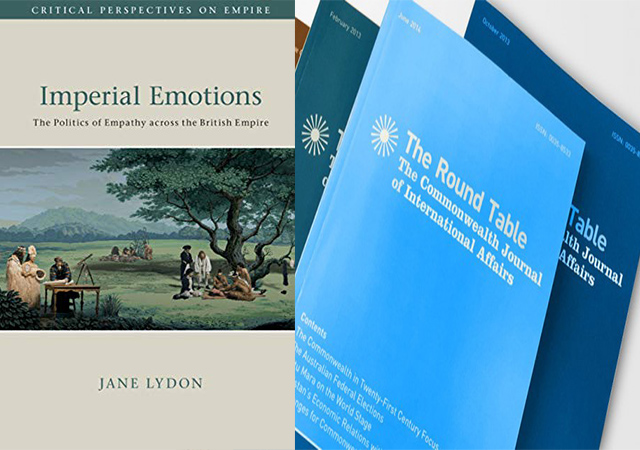
[This is an excerpt from a book review which appears in The Round Table: The Commonwealth Journal of International Affairs.]
This is one of those unexpected book titles that certainly inspire the reader’s curiosity. It joins such works as Richard Grove’s Green Imperialism, Jeffrey Auerbach’s Imperial Boredom, and Joanna Lewis’s Empire of Sentiment in having arresting and faintly provocative names on the cover. In all of these the sub-title is important and this is also true of Lydon’s book: The politics of empathy across the British Empire. This seems to reveal that the emotions to be unveiled are intended to be positive rather than negative ones, particularly as it is suggested that ‘empathy’ constitutes a much wider and more complex phenomenon than ‘sympathy’. However, that sub-title is not entirely honest. The fact of the matter is that the major proportion of the book concentrates on Australia and that ‘across’ is only justified by some consideration of the cultural exchanges between Britain and the pre-federated Australian colonies. There are only slight references to other parts of the British Empire and rather more to slavery in the United States. Moreover, in examining the supposedly empathetic statements of some leading characters in and visitors to Australia, it seems a little disabling that the careers of such figures elsewhere are ignored. An excellent example is Edward Eyre who is quoted as showing some compassion for Aboriginal people after the Rufus River massacre of Aborigines in 1841. Yet this is the same Edward Eyre who became notorious for his utterly brutal suppression (with hundreds of deaths and many executions) of the Morant Bay rebellion when he was Governor of Jamaica in 1865. It is pertinent to ask what happened to him in that quarter century. Why was sympathy for the Aboriginal victims transformed into what amounted almost to blood lust, causing massive controversy in Britain? We also hear of a military figure Godfrey Charles Mundy and his reactions to, and artistic depictions of, Aboriginal people. Yet this is the same Mundy who had a career in India, including the siege and storming of Bhurtpore in 1825–26 when many Indians were killed and large quantities of booty were taken. He later exercised both his prose and his artistic abilities in the depiction of Indians. In imperial ‘empathy’ it is these paradoxes that most require explanation. For the reader genuinely interested in the British World the silence about such figures’ wider careers seems somehow to skew any isolated consideration of their activities in Australia.
Nevertheless, there are some very useful things in this book, of great interest to the cultural historian. We learn of the reception of Stowe’s Uncle Tom’s Cabin in Australia, as well as of the consideration of Dickens’s antagonism towards ‘telescopic philanthropy’ and the manner in which, in a sense, that was reversed in Australian concern for British slum-dwellers rather than for local Aborigines. Such Australian anxiety for social conditions in Britain obviously fed into emigration propaganda. We learn of images of frontier conflict and the ways in which such violence contributed to notions of colonial masculinity. The examination of missionary philanthropy in the Australian colonies, particularly the activities of the fascinating figure John Brown Gribble, is very valuable, as is the analysis of the power of theatrical performances (for example, of Dickens’s crossing sweeper Jo in Bleak House), artistic depictions, and lectures with lantern slides that contributed to the arousing of aspects of imperial empathy. Lydon suggests, indeed, that Bleak House was a direct response to Uncle Tom’s Cabin seeking to transform empathy for the condition of slaves in the United States into sympathy for the London poor. The violence of the ‘Overlanders’, such as George Hamilton, is laid out in relation to the Aboriginal people they encountered in their journeys between Melbourne and South Australia. It is also intriguing that the Australian frontier went through the dynamism of distinct geographical phases, moving from east to west (with the troubled and violent frontier in northern Western Australian consequently available for comment in the more settled and supposedly civilised New South Wales) and also to the north in Queensland and what became the Northern Territory, with serious effects upon Aboriginal peoples in each case. We also hear more of the well-known tragedy of the Stolen Generations of mixed-race and Aboriginal children removed from their family backgrounds in the alleged pursuit of assimilation and ‘civilisation’.
The book ends with a consideration of Australian interest in the British royal family and the failure of republicanism to secure (so far) electoral purchase. While this chapter is interesting, it gives the book a slightly disjointed character. And what of the Aboriginal construction of British monarchy as a ‘deus ex machina’ available for appeal against local grievances, an effect that was common among some African peoples in southern Africa. We hear of this in a different chapter and one can only presume that it played little part in the republican versus monarchy debates of the 1990s.
Imperial emotions: the politics of empathy across the British Empire by Jane Lydon, Cambridge, Cambridge University Press, 2019.
John M. MacKenzie is with the University of Lancaster.



